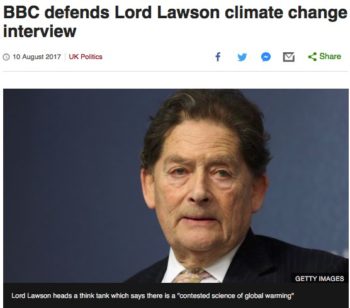
Met Office can’t bear to give facts on hurricanes
It’s normal when somebody like Nigel Lawson appears on the BBC, for the corporation to follow up by giving somebody from the green side of the equation a chance for an unchallenged response. I think this is something to do with the unique way it’s funded.
Today was no exception, with yesterday’s exchanges between Lawson and Al Gore being given a going over by Roger Harrabin and Peter Stott from the Met Office.
Harrabin had been tasked with looking at the claims about the relative levels of subsidy for fossil fuels and renewables, and this was not too bad. Harrabin noted that Lawson was correct in saying that renewables were much more heavily subsidised than fossil fuels in the UK while saying that Gore’s position that things were the other way round on a global level was also true.
There was one amusing bit of Harrabin logic when he said that expenditure on energy saving had countered costs of renewables and therefore the UK was in the middle of the league table of European energy prices. A bit of a non-sequitur there, I think.
Stott was much less satisfactory. In fact, it left a rather unpleasant taste in the mouth.
John Humphrys opened with a good clear question: “So have we seen an increase in great storms?”, to which Stott responded with a very slick demonstration of how you get ahead in the civil service: don’t give clear answers to clear questions.
He said that we were indeed seeing “more extreme weather”, and claimed that the IPCC report refuted Lawson’s claim that there had been no changes in extreme weather and that they were quite clear that we had seen “changes” in many weather extremes.
This was an (ahem) interesting approach because Lawson was actually very clear that extreme weather changes all the time:
Extreme weather events have always happened. They come and go. And some kinds of extreme weather events of a particular time increase, whereas others, like tropical storms, diminish.
When Humphrys pressed Stott on which climate events the IPCC said had increased, Stott again seemed to struggle to give a straight answer, responding with an answer about a Met Office study of heatwaves. This was no doubt because it gave a stronger message than the IPCC’s “medium confidence” that there has been an increase. He also said that we were seeing an effect on heavy rainfall events, which again is not really the impression that you get from the IPCC, which makes the curious statement that there are “Likely more land areas with increases than decreases”.
Still, we learned nothing about the “great storms” that Humphrys had opened with, and which is most people’s idea of what extreme weather looks like. These have unquestionably diminished, just as Lawson said.
But Stott said nothing of this. One could only be left with an abiding impression that he was damned if he was going to let the truth pass his lips.
Read more at The GWPF
The world is presently in an era of unusually low weather disasters. This holds for the weather phenomena that have historically caused the most damage: tropical cyclones, floods, tornadoes, and drought. Given how weather events have become politicized in debates over climate change, some find this hard to believe…The US has seen a decrease of about 20% in both hurricane frequency and intensity at landfall since 1900…Data on floods, drought, and tornadoes are similar in that they show little to no indication of becoming more severe or frequent…”
Dr. Roger Pielke Jr., Risk Frontiers, 31 July 2017

















With the Green nuts blaming everything from ISIS to BURNT TOAST on Global Warming/Climate Change we wont be hearing a end to this all